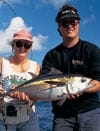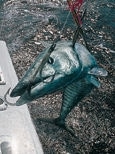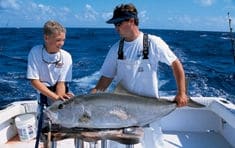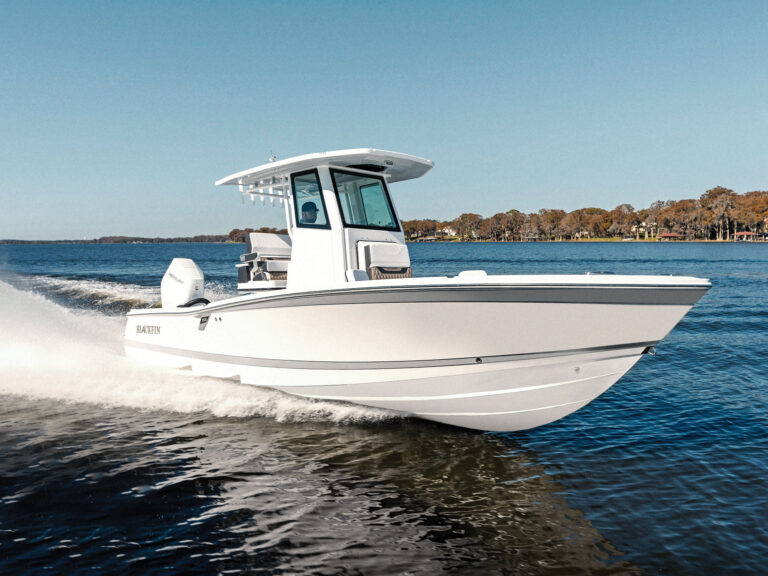
| Anglers in the Florida Keys find action with a variety of species at the humps off Islamorada. |
The Islamorada Hump may be the single best-known fishing spot in all of South Florida. Anyone who fishes offshore in the Florida Keys knows about it, and has probably fished there at least once. And when newcomers ask about the incredible offshore variety in the Keys, questions about the Hump are usually the first thing out of their mouths.
The Hump is so popular, in fact, that on some weekends it can resemble rush hour on I-95 in Ft. Lauderdale. Charter and private boats engage in a complex series of maneuvers beneath large flocks of diving birds, vying for position over what is a relatively small patch of bottom. Inevitably, you find yourself wishing for some type of aquatic traffic cop on days like that. But there are fishing opportunities aplenty, and that makes it worth the effort.

|

| |Blackfin tuna (left) and dolphin (right) are common catches at the humps, providing fast action on light gear.|
There are actually many seamounts off Islamorada, and when the Hump is unbearably crowded (or even when it’s not), these offer excellent alternatives. Two other well-known humps are the 409 Hump and the Marathon Hump, the latter known as the West Hump among Keys locals. These three seamounts are the largest in the area and create substantial upwellings as the ocean current strikes their leading edges, trapping baitfish and attracting predators. Subtle differences between the three make them unique, but they share many common species. On calm days, you can even fish all three of them to see which has the best action.
The Islamorada Hump rises to within 290 feet of the surface, while the 409, as you might expect, is 409 feet deep at the top. The West Hump is just under 500 feet deep. At all three spots, large rips develop when the current is moving hard, and on calm days you can spot these rips from a long way off. And most of the time you’ll see the aforementioned flocks of tuna birds and fish crashing everywhere. Pulling up to a sight like that still excites even the most veteran blue-water fisherman.
One of them is Captain Skip Nielsen ((305) 664-9314; skipcyd@ddtcom.com). Nielsen ran a charter boat in Islamorada for 29 years before “retiring” a couple of years ago. He traded his sportfisherman for a flats skiff, and now runs backcountry charters. He also freelances as a captain-for-hire on private boats, and is widely viewed as one of the most knowledgeable fishermen in the Keys when it comes to fishing the humps. He pioneered many of the techniques that are now common practice when fishing them.
Blackfin Bonanza

Wahoo will hit artificial lures trolled along the edges of the humps.|
Blackfin tuna and amberjack are the two of the best-known species found at the humps, and are generally most plentiful at the same time. “The big blackfins are best at the Islamorada Hump from February through June,” Skip says, “but September and October can be surprisingly good too.” In May, June and July, Skip says the 409 Hump is best when the current is rolling hard. And the summer months at the West Hump produce some of the biggest tuna of the year.
Blackfins are taken on live bait, dead bait and artificials at the humps. “Artificial baits work really well,” Skip explains. “We troll black plastic worms with paddle tails, 4 1/2- to 5 1/2-inch octopus skirts, and small feathers for the tunas.” The octopus skirts are the favorite bait, in pink, black and gold, and purple and blue colors. Skip rigs them on 30- to 50-pound mono with a 1/8- or 1/4-ounce lead inserted in the head of the skirt.
The skirts are rigged with a single long-shank hook and trolled at moderate speeds of around five or six miles per hour (most people troll too fast). Worms are trolled even slower, and the undulating paddle tail often proves irresistible to the tuna. Small feathers can be trolled faster and are deadly when you have to move fast to stay in front of the school.
Pilchards are tops for live-baiting. To fish them, Nielsen rigs up with a short piece of 30-pound fluorocarbon leader, or with a short double line straight to the hook. Owner 3/0 and 4/0 Mutu Light circle hooks are the hooks of choice. When the fish are staying deep or seem leader shy, as often happens when there’s lots of boat traffic, you sometimes have to go with 20-pound or even 12-pound tied straight to the hook and hope you don’t get biten off.
Skip likes to put one live bait in the outrigger after marking the highest point of the Hump. By powering into the current, he stays just off the upcurrent edge and throws out one or two pilchards at a time as freebies. Watching the area behind the boat closely, he waits for a splash as a blackfin or two attack the freebies. He then tosses out a scoop of live baits, which will hide under the boat and hold the tunas close. Lastly, he drops back the hook bait while tossing out a few more pilchards as live chum. This keeps the tunas close to the boat and feeding even as the boat drifts off the hump.
Super Kite Techniques
| ## Hump Etiquette |

Hump regulars often load up on live bait to chum game fish into a frenzy.|
When the humps are crowded, a little courtesy goes a long way. When approaching an area where many boats are fishing, try to determine which way they’re trolling. If everyone trolls in the same direction, it makes life easier.
When approaching diving birds and busting fish, don’t run right into the activity. Instead, circle wide, so your baits are pulled into the frenzy, but your boat doesn’t put the fish down. And don’t ever cut behind a boat that’s actively fishing. Trolled baits are often fished very far back, and live-baiters often have a stream of baits well behind the boat as chum, hoping that the fish will rise.
Before fishing, it’s a good idea to explore the underwater structure with your depthsounder to get a feel for the topography. By getting to know it a little better, and seeing where the various schools of fish are holding, you can hone your technique without charging around blindly, as too many skippers do.
– John Brownlee
One of the newest and most exciting techniques for catching blackfins involves trolling with kites. Nielsen was the first to try this at the Islamorada Hump, and developed the technique after hearing Captain Robert Trosset of Key West describe kite fishing for yellowfin tuna in Bermuda. Skip experimented with a kite flown off to the side of the boat using a rigged flying fish as bait.
“When you see man-o-war (frigate) birds dipping after flying fish, it’s time to break out the kite,” Skip says. “You troll it off to the side so the tuna don’t associate the bait with the boat, and you need to make it splash, crash and skitter.” Skip says he thought of this technique after years of watching blackfins swimming at high speed on their sides, looking up at airborne flying fish. The tuna would pounce on the flyers as soon as they hit the water again.
Rigging for kite trolling consists of a flying fish rigged with the wings pinned open, hooked upward through both jaws, and with a one- or two-ounce weight on top of a long leader. The mate demonstrates the technique to the angler, who then holds the rod as the boat moves forward, pulling downward on the line in jerking motions. This makes the flying fish appear to jump out of the water, or “splash, crash and skitter.” The frantic motion is deadly on big tuna, and is incredibly exciting to watch as the fish attack the bait every time it nears the surface. It’s also a lot of work, but worth perfecting if you’re serious about catching big blackfins.
Monster AJs

Mike Nichols, mate on the How ‘Bout It, assists Ben Brownlee with his 72-pound amberjack.|
Smaller blackfins make great baits for other hump-dwellers, such as big amberjack. The small tuna are caught on feathers and kept alive in tuna tubes or by wrapping the fish upside down in a wet towel and stuffing the boat’s salt water washdown hose in its mouth. Then you run back upcurrent of the hump, hook the tuna through its upper lip and drop it down quickly as you drift toward the area where you’ve marked the jacks on your depthsounder.
On a video sounder, the tunas appear as large, red masses suspended in the water column. The jacks typically hug the bottom along the upcurrent edge of the humps. It’s easy to differentiate between them with a little practice, but it’s somewhat more difficult to time your drop so the live tuna is presented in the middle of the school of jacks.
Heavy tackle is a must, with stout leaders and 8/0 to 10/0 Mustad 7766 hooks, rigged on three-way swivels. Two pounds of lead is not uncommon to reach bottom in heavy current, but if you time it right, the bite usually comes quickly. The amberjack average 50 pounds, but quite a few over 100 pounds are taken each year. The numerous sharks eat lots of them during the fight, but that’s all part of the game.
| ## Finding the Humps |

The humps are great places to take your own boat, or you can charter one. Either way, you won’t be disappointed.Islamorada Hump 24 ¿ 48.206′ N 80 ¿ 26.598′ W409 Hump 24 ¿ 35.853′ N 80 ¿ 35.459′ WMarathon (West) Hump 24 ¿ 25.736′ N 80 ¿ 45.405′ W|
Nielsen has a favorite method for taking big amberjack at the Islamorada Hump. He catches a “football” blackfin, between four and eight pounds, then runs far upcurrent to the southwest, as much as half a mile away. He then hooks the tuna in the shoulder and free-lines it out with no weight. He says the tuna will make a beeline for the bottom every time, and if you’ve timed your drift right, it’ll swim right into the hungry horde of jacks.
Grouper and Snapper, Too
Dead, butterflied small tuna make great baits too, and attract groupers such as scamp, blacks and Warsaws. The humps were once loaded with large Warsaws, but they’ve suffered from heavy fishing pressure and are far less numerous. But there are still quite a few caught each year, even now. It pays to make a few drifts with a butterflied bait just to see if a hungry Warsaw is lurking below.
Snapper species found on the humps include vermillion and yelloweye. These are caught on “chicken rigs” – basic three-hook rigs tied with 80-pound mono and baited with squid. Chicken rigs are usually fished on electric reels because of the depths, but if you don’t mind cranking up repeatedly from depths of 300-plus feet, you certainly can catch them on conventional gear.
| ## Islamorada Charter Docks | ||
| Bud-N-Mary’s Marina (305) 664-2461Caloosa Cove Marina (305) 664-4455Holiday Isle Marina (305) 664-2321Whale Harbor Marina (305) 664-4511 |
Finally, we should mention the pelagic species that swim around the humps. In spring and summer, dolphin abound around the 409 and West Humps and the waters in between, and wahoo are taken year-round at all three humps as they feed on small tuna. The humps are great places to troll swimming plugs for wahoo, and you should always have a live-bait rod rigged with wire leader and ready to go when you’re tuna fishing. If you get a cut-off, deploy it quickly and a big wahoo may be your reward.
The West Hump is undoubtedly the best place to catch a blue marlin off Islamorada. In late May and June, knowledgeable captains live-bait with football tuna around the West Hump early in the morning and late in the evening, a technique that has yielded some very large fish over the years. The West Hump holds huge blackfins during the first two weeks of June, and large skipjack tuna all summer.
With such a wide variety of species to fish for, it’s no wonder the humps can get crowded, but with a little consideration for one another (see sidebar) there’s enough room for all of us. The rewards can be fantastic, and that’s what keeps guys like Skip Nielsen coming back year after year.









